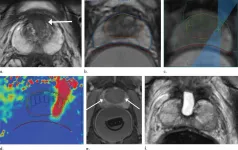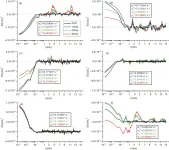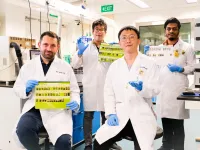(Press-News.org) OAK BROOK, Ill. - A technique that delivers high-intensity focused ultrasound to targeted tissue under MRI guidance effectively treats intermediate-risk prostate cancer with minimal side effects, according to a study published in Radiology.
Prostate cancer is the most common cancer among men, aside from non-melanoma skin cancers. Common treatments to the entire gland, such as surgery and radiation therapy, are effective in eliminating the cancer, but they often leave patients with incontinence and sexual dysfunction.
A class of treatments called focal therapy offers an alternative for some men with intermediate-risk disease that is still confined to the prostate. In focal therapy, the cancer is ablated, or destroyed, by either heating or freezing the target tissue. Since the treatment is targeted to a small area within the prostate, side effects are generally less significant than those associated with surgery and radiation therapy.
High-intensity focused ultrasound is an example of focal therapy in which an ultrasound transducer focuses sound waves to generate heat at a single point within the body and destroy the target tissue. In the past, it has been performed under ultrasound guidance, but ultrasound does not visualize the site of cancer within the prostate gland well enough to allow for a targeted approach.
For the new study, researchers studied a device that delivers MRI-guided focused ultrasound (MRgFUS). While the patient is under general anesthesia, a probe is placed in the rectum that focuses high-frequency ultrasonic waves to the site of the cancer. The procedure takes approximately four hours to perform.
"By combining the high-intensity focused ultrasound device with MRI, we can target our treatment to the exact location, because we're able to pinpoint precisely where the tumor is," said the study's principal investigator and lead author Sangeet Ghai, M.D., at Toronto's Joint Department of Medical Imaging, part of the University Health Network (UHN) Sinai Health and Women's College Hospital.
Dr. Ghai and colleagues from UHN and Sinai Health performed MRgFUS on 44 men with prostate cancer and tracked their outcomes using MRI, biopsies and surveys of erectile and urinary function.
Treatment was successfully completed in all the men. There were no major treatment-related adverse events, and 41 of 44 participants, or 93%, were disease-free at the treatment site on five-month biopsy.
Scores for erectile function and prostate symptoms were similar at baseline and five months.
"The results so far have been very good," Dr. Ghai said. "We treated a smaller area using this device, yet still had very good results. At the same time the patients preserved their erectile and urinary function."
Although MRgFUS requires additional expertise, resources and cost, it has several key advantages over other approaches. Use of MRI allows for thermal feedback during treatment, an important consideration since killing the cancerous tissue requires a temperature of more than 60 degrees Celsius.
"MRI almost instantaneously gives feedback as to the temperature that we've been able to achieve at the site," Dr. Ghai said. "If the temperature was not what I wanted to get, I can reheat that area so that chances for successful treatment increase."
An additional benefit of MRI is that it can show if there is any remaining vascularity in the treatment area, a sign that not all the cancer has been eradicated.
Pending approval from the U.S Food and Drug Administration and Health Canada, MRgFUS has promise as an option for intermediate-risk patients who want their prostate cancer eradicated without diminishing their quality of life, a group that makes up a potentially significant number of patients. Dr. Ghai estimates that of all the prostate cancer patients who go on to get surgery or radiation therapy, approximately 20% to 30% would be eligible for some type of focal therapy like MRgFUS.
As part of the study, the researchers are collecting two-year follow-up data from all patients in the study group and plan to publish the results in another manuscript.
INFORMATION:
"MRI-guided Focused Ultrasound Ablation for Localized Intermediate-Risk Prostate Cancer: Early Results of a Phase II Trial." Collaborating with Dr. Ghai were Antonio Finelli, M.D., FRCSC, Kateri Corr, B.Sc., Rosanna Chan, M.R.T.(MR)(N), Sarah Jokhu, H.B.Sc., C.C.R.P., Xuan Li, Ph.D., Stuart McCluskey, M.D., Ph.D., FRCPC, Anna Konukhova, Ph.D., Eugen Hlasny, M.R.T.(MR), Theodorus H. van der Kwast, M.D., Ph.D., FRCPC, Peter F. Incze, M.D., FRCSC, Alexandre R. Zlotta, M.D., Ph.D., FRCSC, Robert J. Hamilton, M.D., M.P.H., FRCSC, Masoom A. Haider, M.D., FRCPC, Walter Kucharczyk, M.D., FRCPC, and Nathan Perlis, M.D., M.Sc., FRCSC.
Radiology is edited by David A. Bluemke, M.D., Ph.D., University of Wisconsin School of Medicine and Public Health, Madison, Wisconsin, and owned and published by the Radiological Society of North America, Inc. (https://pubs.rsna.org/journal/radiology)
RSNA is an association of radiologists, radiation oncologists, medical physicists and related scientists promoting excellence in patient care and health care delivery through education, research and technologic innovation. The Society is based in Oak Brook, Illinois. (RSNA.org)
For patient-friendly information on prostate imaging, visit RadiologyInfo.org.
By late summer 2020, the resurgence of COVID-19 in the United States was largely driven by adults between the ages of 20 and 49, a new study finds. The results indicate that in locations where novel highly transmissible SARS-CoV-2 lineages have not yet established, additional interventions among adults of these ages could bring resurgent COVID-19 epidemics under control and avert deaths. Following initial declines in the number of reported SARS-CoV-2 infections and deaths - a result largely attributed to non-pharmaceutical interventions - a resurgence in transmission of COVID-19 occurred in the United States and Europe beginning in August 2020. Understanding the age demographics that drove this is crucial. For example, between August ...
Laser particles are micrometre and nanometre lasers in the form of particles dispersible in aqueous solution, which have attracted considerable interest in the life sciences as a promising new optical probe. Laser particles emit highly bright light with extremely narrow spectral bandwidth. By transferring laser particles into live cells as shown in Figure 1, individual cells in a heterogeneous population can be tracked using each intracellular particle's specific spectral fingerprint as an optically readable barcode. However, laser particles emit directional light (Figure 2) and freely tumble inside living cells, their orientation varying randomly over time. Therefore optical readout of these labels results ...
Loess Plateau possesses a particular loess physiognomy with numerous ravines and slopes, and tableland is a typical landform in it. Together, the ununiform in both topographic undulation and land coverage compose the ununiform, complex underlying surface on Loess Plateau. This provides a special platform for research of turbulence above the complex underlying surface.
As the front-edge problem encountered in the atmospheric boundary layer thesis, the turbulence research for complex underlying surface has drawn extensive attention recently. Local similarity has already proven that under certain condition, theories of turbulence based on the uniform underlying surface can also be applied to which for the ununiform underlying surface. ...
A team from Nanyang Technological University, Singapore (NTU Singapore) has developed a portable device that produces high-resolution 3D images of human skin within 10 minutes.
The team said the portable skin mapping (imaging) device could be used to assess the severity of skin conditions, such as eczema and psoriasis.
3D skin mapping could be useful to clinicians, as most equipment used to assess skin conditions only provide 2D images of the skin surface. As the device also maps out the depth of the ridges and grooves of the skin at up to 2mm, it could also help with monitoring wound healing.
The device presses a specially devised film onto the subject's skin to obtain an imprint of up to 5 by 5 centimetres, which is then ...
A satellite-based dataset generated by KAUST researchers has revealed the dynamics of dust storm formation and movements over the last decade in the Arabian Peninsula. Analysis of this long-term dataset reveals the connection between the occurrence of extreme dust events and regional atmospheric conditions, a finding that could help improve weather forecasting and air-quality models.
Dust storms occur when strong winds lift tiny particles of sand into the atmosphere. These events often span several miles and can have an enormous impact on daily life, from damaging buildings and disrupting air traffic to triggering respiratory illnesses and other health problems.
The Arabian Peninsula is a global hotspot of extreme dust events, with storms occurring ...
Residential gardens are a poor substitute for native bushland and increasing urbanisation is a growing threat when it comes to bees, Curtin University research has found.
Published in 'Urban Ecosystems', the research looked at bee visits to flowers, which form pollination networks across different native bushland and home garden habitats.
Lead author, Forrest Foundation Scholar Miss Kit Prendergast, from Curtin's School of Molecular and Life Sciences said the findings highlight the need to prevent destruction of remaining bushland and preserve native vegetation, in order to protect sustainable bee communities and their pollination services.
"Our study involved spending hundreds of hours at 14 sites on the Swan Coastal Plain at Perth, Western Australia, ...
Researchers have shown how disposable face masks could be recycled to make roads, in a circular economy solution to pandemic-generated waste.
Their study shows that using the recycled face mask material to make just one kilometre of a two-lane road would use up about 3 million masks, preventing 93 tonnes of waste from going to landfill.
Developed by researchers at RMIT University in Melbourne, Australia, the new road-making material is a mix of shredded single-use face masks and processed building rubble designed to meet civil engineering safety standards. ...
Researchers from Peter the Great St.Petersburg Polytechnic University (SPbPU) in collaboration with colleagues from Belgium take a step in the development of genome editing technology. Currently it is possible to deliver genetic material of different sizes and structures to organs and tissues. This is the key to eliminating DNA defects and treating more patients. The project is guided by Professor Gleb Sukhorukov and supported by the Russian Science Foundation. Research results were published in Particle & Particle Systems Characterization journal.
An international research group developed a polymer ...
Semiconducting 2D alloys could be key to overcoming the technical limitations of modern electronics. Although 2D Si-Ge alloys would have interesting properties for this purpose, they were only predicted theoretically. Now, scientists from Japan Advanced Institute of Science and Technology have realized the first experimental demonstration. They have also shown that the Si to Ge ratio can be adjusted to fine tune the electronic properties of the alloys, paving the way for novel applications.
Alloys--materials composed of a combination of different elements or compounds--have played a crucial role in the technological development of humans since the Bronze Age. Today, ...
The Bronze Age (2200 to 800 BC) marked a decisive step in the technological and economic development of ancient societies. People living at the time faced a series of challenges: changes in the climate, the opening up of trade and a degree of population growth. How did they respond to changes in their diet, especially in Western Switzerland? A team from the University of Geneva (UNIGE), Switzerland, and Pompeu Fabra University (UPF) in Spain has for the first time carried out isotopic analyses on human and animal skeletons together with plant remains. The scientists discovered that manure use had become widespread over time to improve crop harvests in response to demographic growth. The researchers also found that there had ...




